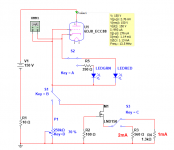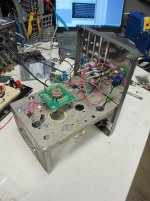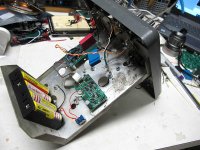Is it safe to assume that the 12AX7 is the best tube for the input stage ?
I mean new production tubes.
I mean new production tubes.
Is it safe to assume that the 12AX7 is the best tube for the input stage ?
I mean new production tubes.
Perhaps on a $ adjusted basis.
D3a's wired as triode are great, if you can find them. Ten years ago they were $8 - $10 each.
I don't think that Scott included the 417a/5842 which are now quite rare.
Last edited:
Thank you.
I don't really care about the price, I am not a manufacturer, I want to select the best tube (lowest noise possible, if it's pricey I will swallow it) for my microphone amplifier. Double triode is convenient.
Do you guys recommend 12AX7 cascaded or paralleled ?
For ultimate input stage, getting the lowest noise and the best signal-to-noise ratio ? Or can I do better with another tube ? (I don't care about the sound/sonic signature)
I said new production because you can have them easily without going the NOS route. And you can easily replace it if its a noisy sample.
I don't really care about the price, I am not a manufacturer, I want to select the best tube (lowest noise possible, if it's pricey I will swallow it) for my microphone amplifier. Double triode is convenient.
Do you guys recommend 12AX7 cascaded or paralleled ?
For ultimate input stage, getting the lowest noise and the best signal-to-noise ratio ? Or can I do better with another tube ? (I don't care about the sound/sonic signature)
I said new production because you can have them easily without going the NOS route. And you can easily replace it if its a noisy sample.
JJ 12AY7 has been used by some of my customers in microphone service.Thank you.
I don't really care about the price, I am not a manufacturer, I want to select the best tube (lowest noise possible, if it's pricey I will swallow it) for my microphone amplifier. Double triode is convenient.
Do you guys recommend 12AX7 cascaded or paralleled ?
For ultimate input stage, getting the lowest noise and the best signal-to-noise ratio ? Or can I do better with another tube ? (I don't care about the sound/sonic signature)
I said new production because you can have them easily without going the NOS route. And you can easily replace it if its a noisy sample.
All tubes with high gm (=low Rp) have the lower noise.
In most case the gain is lower than ones with low gm as 12AX7.
As said by Jack some pentode in triode mode give you a great results
One example if EF184 or similar in triode mode.
For the microphone if it has a low impedance as Zout I suggest the use of a coupling trafo with a ratio of 1:10 or 1:20 ( 20 or 26 dB) then a 6922 selected, in this way you can get a total of 44-48- dB of total that is fine .
I made an 8 channel mic preamp with trafos and 6922, powered full battery ; this stuff was used to record some cd.
Walter
Walter
In most case the gain is lower than ones with low gm as 12AX7.
As said by Jack some pentode in triode mode give you a great results
One example if EF184 or similar in triode mode.
For the microphone if it has a low impedance as Zout I suggest the use of a coupling trafo with a ratio of 1:10 or 1:20 ( 20 or 26 dB) then a 6922 selected, in this way you can get a total of 44-48- dB of total that is fine .
I made an 8 channel mic preamp with trafos and 6922, powered full battery ; this stuff was used to record some cd.
Walter
Walter
Low internal Rp is lower noise, that is what I was thinking at first. But how come in tavishdad measurements it's not the case ? a 12AY7 Integrated Noise Figure is 10.1dB and the 12AX7 is 8.3dB ?
I don't understand, please help me.
Also Having most gain possible at the fist stage should improve the SNR ?
I don't understand, please help me.
Also Having most gain possible at the fist stage should improve the SNR ?
About s/n is better to use, as said before, the step up trafos, first of all.
to improve the s/n with active stuff you need to use the lowest noise tube.
The solution is not to have more gain.
Regarding the test for noise the standard procedure need a wighted "A" filter to have a realistic results.
This a international procedure for audio equipments to measure the s/n
In Audioreview magazine in Italy we do this test daily on different products.
Walter
to improve the s/n with active stuff you need to use the lowest noise tube.
The solution is not to have more gain.
Regarding the test for noise the standard procedure need a wighted "A" filter to have a realistic results.
This a international procedure for audio equipments to measure the s/n
In Audioreview magazine in Italy we do this test daily on different products.
Walter
Last edited:
ECC88/6DJ8/6922 is in current production and is lower noise than 12AX7. You can use the sections in parallel for even lower noise if you wish.Thank you.
Double triode is convenient.
I said new production
Thank you guys.
Waltube, I will look into it thanks.
Thank you Merlinb, for the recommendation, I already saw it in you book sample. I wanted to use the 12AX7 over, because it is higher gain. I thought, I will get the utmost gain to bring the signal above the noise floor as much as I can.
For the case of the ECC88, it makes sens it is lower noise than12AX7. It has lower Ra, and the highest Gm and and good mu of 33.
Yet I can't make sens why a 12AX7 is still lower noise than the 12AY7 and 12AT7, they have better transconductance and lower Ra.
Grid current is it ?
I know I am bothering everyone, but I would really like to understand it.
Sorry.
Waltube, I will look into it thanks.
Thank you Merlinb, for the recommendation, I already saw it in you book sample. I wanted to use the 12AX7 over, because it is higher gain. I thought, I will get the utmost gain to bring the signal above the noise floor as much as I can.
For the case of the ECC88, it makes sens it is lower noise than12AX7. It has lower Ra, and the highest Gm and and good mu of 33.
Yet I can't make sens why a 12AX7 is still lower noise than the 12AY7 and 12AT7, they have better transconductance and lower Ra.
Grid current is it ?
I know I am bothering everyone, but I would really like to understand it.
Sorry.
To Federico
Is not a good idea to use the 12AX7, the gain is not the problem.
In entire circuit the noise is the sum of different parts. With AX7 you must use anode resistor of high value and this is a source of noise.
In addition the Zout of a single stage with AX7 is very high so you need an additional stage to match the Z with the next stuff as CF, p.e. example.
If you need an amp for mic ( maybe balanced) is better to use, as told before, a step up trafo and a 6922/ECC88/PCC88/6DJ8 with a Vdc around 120 volt and an anode resistor of 10k, in this case the total gain is good and the Zout is reasonable low.
If it is not balanced, puttin in paralllel the two section of 6922 you can get same gain but 6dB lower noise ( theory) and the Zout is also good.
But all this results need the use a very good power supply; battery is the maximum but a regulated supply is strictly suggested.
Regarding the difference between AX7 and AY7 the noise figure written on data sheet aren't significative.
You must look on the entire circuit and the AY7 give around 3 dB better s/n results.
In the last phono I made and presented on Audioreview magazine, the changing from AX7 to 6072 (=12AY7) gave 3 db better on s/n, 80 against 77 db
In addition a very goos selection, in every case, is mandatory for microphonics, noise and gain for the two sections (must be equal)
Walter
Is not a good idea to use the 12AX7, the gain is not the problem.
In entire circuit the noise is the sum of different parts. With AX7 you must use anode resistor of high value and this is a source of noise.
In addition the Zout of a single stage with AX7 is very high so you need an additional stage to match the Z with the next stuff as CF, p.e. example.
If you need an amp for mic ( maybe balanced) is better to use, as told before, a step up trafo and a 6922/ECC88/PCC88/6DJ8 with a Vdc around 120 volt and an anode resistor of 10k, in this case the total gain is good and the Zout is reasonable low.
If it is not balanced, puttin in paralllel the two section of 6922 you can get same gain but 6dB lower noise ( theory) and the Zout is also good.
But all this results need the use a very good power supply; battery is the maximum but a regulated supply is strictly suggested.
Regarding the difference between AX7 and AY7 the noise figure written on data sheet aren't significative.
You must look on the entire circuit and the AY7 give around 3 dB better s/n results.
In the last phono I made and presented on Audioreview magazine, the changing from AX7 to 6072 (=12AY7) gave 3 db better on s/n, 80 against 77 db
In addition a very goos selection, in every case, is mandatory for microphonics, noise and gain for the two sections (must be equal)
Walter
Last edited:
The ECC83 has very little 1/f noise, as you can see in Merlin's measurements. I don't know why either; maybe a better cathode than most valves?
It is probably this. I was reading about tungsten content of the cathodes and how it differs between manufacturer and tube types.
Thank you very much, I will do my best to try to explain this, If I find anything I will post it.
Also waltube I will try everything you mentioned in my preamp, and will probably remove the 12AX7 in one channel and AB. And you are right the circuit is also important not the tube only. Thank you.
Thank you very much, I will do my best to try to explain this, If I find anything I will post it.
Also waltube I will try everything you mentioned in my preamp, and will probably remove the 12AX7 in one channel and AB. And you are right the circuit is also important not the tube only. Thank you.
That is interesting. I will definitely build this when I have the time.
Thank you very much jackinnj.
Thank you very much jackinnj.
6922 is delivering 108 db s/n (1 w) driving the tone stack into my amplifier.
100db /w/ m tweeter, hiss can faintly be heard with your ear pressed against it.
100db /w/ m tweeter, hiss can faintly be heard with your ear pressed against it.
That is interesting. I will definitely build this when I have the time.
Thank you very much jackinnj.
On second thought, the 390 resistor will add noise. I had thought of using an 1N914 diode, but the fluorescent light modulates the PN junction. Mbe just a low noise NPN transistor as diode.
It would be helpful to dial up the current sink for more values so the slide switch will be replaced with a rotary or potentiometer.
Changed the DMOS to DN2540 which has a wider range of current than the LND150.
Attachments
It isn't pretty, but it works -- ganged up an OPA1654 for ~2.4nV/RtHz. Battery pack is 16x 9V alkalines. The Eico 250 had a broken meter and was purchased for a couple bucks -- the great thing about the Eico VTVM's of the era is that the chassis and surround are steel, not aluminum so line interference is mitigated. Power for the filaments is provided with a pack of 18650's -- these also drive one of Jan's "Silent Switchers":
Attachments
ECC88/6DJ8/6922 is in current production and is lower noise than 12AX7. You can use the sections in parallel for even lower noise if you wish.
I have not found any current production 6922/6DJ8/ECC88 with consistently low noise. See my list. The JJ was inconsistent, and all Russian manufactured tubes were noisy. But that data is now a few years old. Maybe one of them has improved. Can you tell me which brand/type? Thanks!
Scott
- Home
- Amplifiers
- Tubes / Valves
- List of Tube Noise Measurements - please nominate lowest noise tubes




